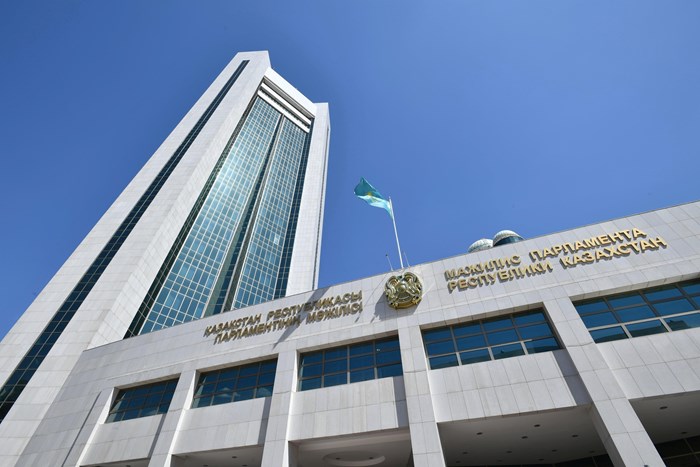ASTANA – As Kazakhstan gears up for the upcoming Mazhilis election on March 19, eyes are on the country’s changing political landscape, although some of these changes are not new to Kazakhstan. The Astana Times looks back at all the previous parliamentary elections in Kazakhstan since the country’s independence in 1991 to see how the political landscape has changed over the years.

Building of Mazhilis in Astana. Photo credit: parlam.kz
The Mazhilis is the lower chamber of the Kazakh Parliament that was established more than 27 years ago when the Constitution, adopted in 1995, defined the Parliament as the highest representative body exercising legislative functions and consisting of two chambers.
Stemming from last year’s constitutional changes, the Mazhilis will be made up of 98 members (MPs) instead of the previous 107, with MPs elected for a five-year term. Sixty-nine of the seats will be filled by party lists and 29 through single-mandate districts.
Twelve million people are eligible to vote.
The country’s first Mazhilis election took place in December 1995, shortly after the adoption of a new Constitution. Sixty-seven MPs were elected solely from single-mandate districts, which Kazakhstan has now brought back. The MPs had different backgrounds, from heads of local executive bodies to workers in science and education. However, only nine were women.
The second Mazhilis vote was held in 1999, with 77 seats up for election. For the first time, political parties were given an opportunity to get their representatives in the parliament through the party lists on the basis of proportional representation. Sixty-seven MPs were elected from single-mandate districts and ten from party lists.
Ten political parties participated in that election, and 547 candidates registered in the majoritarian single-mandate districts. The competition was unprecedented for Kazakhstan, with an average of eight candidates per seat. To get a seat in the Mazhilis, parties had to pass a seven percent threshold. Women were severely under-represented, with just eight MPs out of 77.
The third Mazhilis election took place in 2004, with twelve parties competing for 77 seats. The proportional-majoritarian system was still in place for this election, with 67 elected from single-mandate districts. Political parties nominated 59 MPs, while 18 were self-nominated.
Eight MPs in the third convocation were women, while the youngest MP was 28 years old.
This was the last election where single-mandate candidates were the majority.
The fourth Mazhilis election in August 2007 was held under different rules stemming from the amendments to the Constitution adopted in May of the same year. The Mazhilis now comprised 107 MPs, and 98 of them were elected by party lists on the basis of universal, equal, and direct suffrage by a secret ballot from a single nationwide constituency. The remaining MPs were elected from the Assembly of the People of Kazakhstan, an advisory body in charge of the inter-ethnic and inter-religious dialogue.
Similar to previous elections, the Nur Otan party (which changed its name to Amanat last year) was the only party passing the seven percent threshold and thereby taking all 98 seats in the Mazhilis. Seventeen of the MPs were women.
Seven political parties participated in the Mazhilis election in January 2012, with three gaining seats in Parliament, including Nur Otan (80.99 percent of votes), Aq Jol party (7.47 percent), and the Communist People’s Party of Kazakhstan (7.19 percent), which was later renamed the People’s Party. Once again, Nur Otan won a majority, taking 83 seats.
The sixth convocation of the country’s Mazhilis, elected in March 2016, was similar to the preceding election, as the same three parties – Nur Otan (82.2 percent of votes), Aq Jol party (7.18 percent), and the Communist People’s Party of Kazakhstan (7.14 percent) – gained seats in Parliament. New MPs made up 60 percent of the composition of the Mazhilis, however, female representation was still low, with just 27 percent of the seats taken by women.
The last election to the country’s lower chamber took place in January 2021. Five political parties participated, and the same three passed the seven percent threshold. The proportional system was still in place, with 98 MPs elected by party lists and nine elected from the Assembly of the People of Kazakhstan.
While a term in office is five years, there is no norm prohibiting an MP from being re-elected. The seventh convocation included 32 MPs from the previous convocation.
This convocation did not make any progress in ensuring a larger female or youth representation. Seventy-three percent of elected MPs were men, and only 29 MPs were women.
For the upcoming election, parties were obliged to ensure that women, youth and people with special needs account for at least 30 percent of the party list. The threshold for political parties to gain seats in the Mazhilis has been reduced from seven to five percent.
Not all parliamentary elections in Kazakhstan took place as scheduled. The upcoming vote is not an exception. President Kassym-Jomart Tokayev initially announced the proposal to hold the early election to the Mazhilis in his state-of-the-nation address in September last year, and on Jan. 19, he set the date for March 19, after dissolving the chamber.

